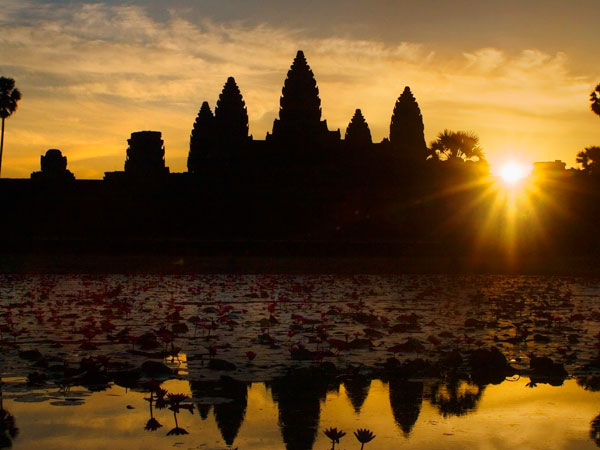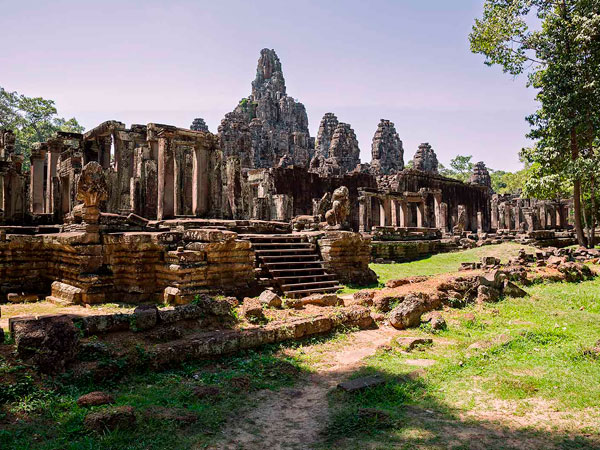Location: Approx. 60 km northeast of Siem Reap
Construction period: Early 11th century C.E.
Religion: Hindu
Built by: King Suryavarman II
Building style: Angkor Wat
Beng Mealea is a jungle temple is more than 1 sq km in area, and is mostly overgrown by vegetation. It has been left the way it was discovered, similar to Ta Phrom Temple. With many trees growing out of broken-down towers and galleries, and vegetation covering ruined structures, it provides the opportunity for some great ‘lost temple’ photos.
However, because it has been left in this condition, in some places you have climb over ruined walls, and climb through windows in order to get around. There is a wooden walkway for the standard tour, and for those who don't want to scramble over stone blocks.
The temple was built in the Angkor Wat style, but was constructed before Angkor Wat, and it is theorised that it may have been a model for Angkor Wat. There are a few lintel and doorway carvings, but no bas-reliefs. There is speculation that when the temple was built, the walls may have been covered with painted scenes, or frescos. The location of this temple is at the crossroads of ancient roads leading to Angkor, Koh Ker, Preah Vihear, and Vietnam.
The trip to Beng Mealea can be combined with a visit to the Roluos Group, or in combination with Banteay Srei and Kbal Spean. From Siem Reap, the road to the temple is a graded dirt road, and the trip takes 1-2 hours. However flooding can occur in the rainy season. An Apsara Authority admission pass is not needed, but there is a $5.00 entrance fee.
Prasat Beng Mealea was built by king Suryavarman II, early 12th century by primary deity to Vishnu with architecture of Angkor Wat.
This temple is located 40 km east of the main group of temples at Angkor, and 77 km from Siem Reap by road.
Beng Mealea (its name means "lotus pond") is a temple in the Angkor Wat style located 40 km east of the main group of temples at Angkor, Cambodia, on the ancient royal highway to Preah Khan Kompong Svay.
It was built as hinduist temple, but there are some carvings depicting buddhist motifs. Its primary material is sandstone and it is largely unrestored, with trees and thick brush thriving amidst its towers and courtyards and many of its stones lying in great heaps. For years it was difficult to reach, but a road recently built to the temple complex of Koh Ker passes Beng Mealea and more visitors are coming to the site, as it is 77 km from Siem Reap by road.
The history of the temple is unknown and it can be dated only by its architectural style, identical to Angkor Wat, so scholars assumed it was built during the reign of king Suryavarman II in the early 12th century. Smaller in size than Angkor Wat, the king's main monument, Beng Mealea nonetheless ranks among the Khmer empire's larger temples: the gallery which forms the outer enclosure of the temple is 181 m by 152 m. It was the center of a town, surrounded by a moat 1025 m by 875 m large and 45 m wide.
Beng Mealea is oriented toward the east, but has entrance ways from the other three cardinal directions. The basic layout is three enclosing galleries around a central sanctuary, collapsed at present. The enclosures are tied with "cruciform cloisters", like Angkor Wat. Structures known as libraries lie to the right and left of the avenue that leads in from the east. There is extensive carving of scenes from Hindu mythology, including the Churning of the Sea of Milk and Vishnu being borne by the bird god Garuda. Causeways have long balustrades formed by bodies of the seven-headed Naga serpent.
It was built mostly of sandstone: Beng Mealea is only 7 km far from the angkorian sandstone quarries of Phnom Kulen, as the crow flies. Presumably sandstone blocks used for Angkor were transported along artificial water canals and passed from here. Despite of lack of information, the quality of architecture and decorations has drown the attention of French scholars just from its discovery.











